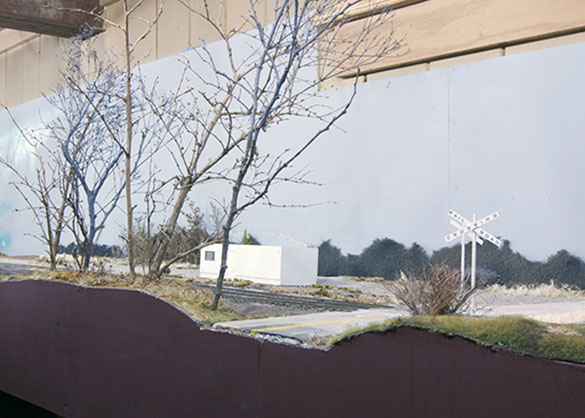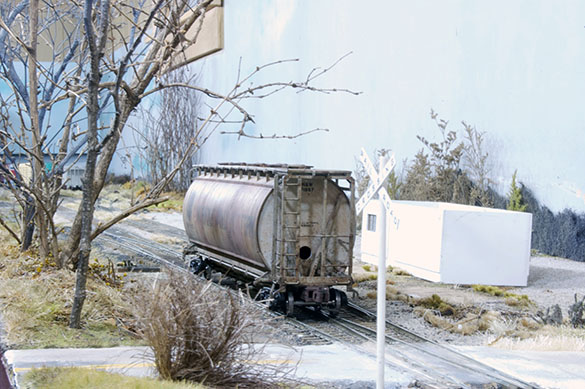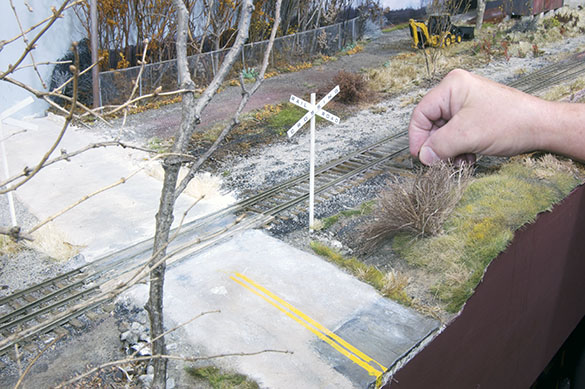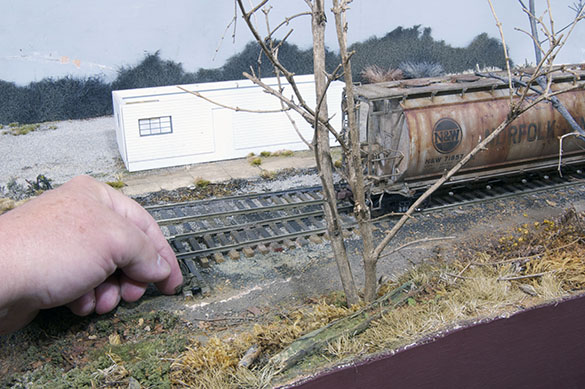Trees are one of those hot button subjects. We’re amazed at well detailed tree models but let’s face it, they’re a pain, not only to build but placing them too. Volume 09 of The Missing Conversation is all about tree modeling (coming June 30, 2014). In addition to a detailed look at full-size trees, Trevor Marshall wrote a wonderful article with loads of beautiful photos showing how he’s using tree models on his layout. You’ll love it.
One thing he covers is tree placement in his rendition of the Lynn Valley. He’s placed numerous trees between the front edge of the layout and the single track that runs through this section. Traditional thought urges zealous caution about placing anything between the aisle and the track. Obscure free access to said track and that’s where the gremlins will setup housekeeping for the life of the layout. We’ve had that thought drilled into our heads for decades. (I find it amusing that we’ll bury track inside a tunnel without the slightest twinge of worry.) In Trevor’s situation, it’s just open running, except for an occasional water stop at the Lynn Valley tank, and he allowed for clever sight lines through the trees to spot tenders at the tank. What are the real issues involved in placing tall objects in front of the track? They vary according to the operations required in the scene.
On the I&W, I placed a cluster of trees in front of the track near the Mill St. crossing. These trees are tall and reach over my head. There are also a couple of branches that extend over the track and I made certain there was plenty of clearance for passing trains.
On a shelf layout like mine, vertical elements are critical to counter that table-top appearance. In addition to acting as a scene divider, this small woodlot creates a mini-scene for the eye to linger over.
Like Trevor’s Lynn Valley, operations are quite simple through this area. When planning the scenery here, I had to allow for operators (me) to reach in and work the ground throws for two turnouts in this area. (There were four originally before I removed the excess trackage on the layout.) Sight lines for throwing the turnouts are not an issue because I was careful to put trees where they wouldn’t get in the way, but could still act as a view block.
The ground throw for the end of the runaround is well away from the trees, so reaching in to throw this turnout isn’t a problem (photo below). As you see in the photo, where I actually reach in to throw the switch, the scenery is nothing but groundcover that won’t be damaged from contact with my hand. The ground throw for the Pole Track at the opposite end of this woodland is much closer, yet still has plenty of clearance for oversized hands to do the work and again, there is a simple treatment of scenery surrounding the reach in area.
Because of the generous size of quarter-inch scale, throwing the two turnouts that used to be on the back track wasn’t a problem because I had plenty of room from both ends of the woodlot to reach my hand into the scene.
Obviously, there’s still work to do in this area and if needed, I can remove the trees to prevent damage and to give unimpeded access. Once the background is completed, I’ll add more saplings and taller growth among the mature trunks for more visual interest.
Regards,
Mike




Interesting thoughts, Mike: placement is important on a layout – just like it is with structures. In fact, trees are structures, just made by nature and not man!
The modelling of trees is definitely the poor relation on most layouts, yet the basic technique is still the same as that espoused by the late George Iliffe-Stokes in the 1950s: a wire armature, and then some form of foliage added to the extremities. The materials have changed and improved over the years, but the core methodology remains. How about this examplefrom his Ravensbourne layout. More than half a century ago?
Simon
“In fact, trees are structures, just made by nature and not man!”
Simon, that is a brilliant thought, and a connection I hadn’t made. Mind if I elaborate on that idea in the future?
Mike
Mike,
Feel free to go ahead! Especially if you are going to be that nice about it.
Simon
Simon,
Thank you. For now, I’d like to hear more of yours and others thoughts about using trees on a layout.
Mike
One key point about trees is that they set the layout in a specific season, and other flora can even set it it in a specific month, as could lighting.
I’m one of those people who struggles to tell a lime from an elm, mind you. To anyone who can most layouts must be very annoying.
Simon will remind me if I’m wrong but I think Iliffe-Stokes tried to model specific trees from life rather than making them up as he went along. In the age of digital photography that is probably easier than ever in terms of collecting the source material. Especially if you can photograph the same tree in different seasons, both with and without foliage.
In structural terms size comes into play. I suspect most of us are quite bad at guessing how tall, or not, trees are. But I do think they can be key structural elements in developing a scene.
Regards
James
Are you are about that invite, Mike? I have a lot of thoughts, although they all boil down to understanding the real thing.
Simon
Then boil them down and give us the concentrated form. If you don’t want to do so here, you know how to find me.
Mike
Mike, as I said, it boils down to observation and understanding, but at length…
Jim is right: George modelled from reality – what he saw, not what he thought he saw. Mother nature has developed some interesting mathematical properties in flora, and for all I know, fauna. The number of branches, for instance, in terms of distance from the root-bowl or some such, follows the Fibonacci series, or so I was told at school when I was 14. The point is, like fractal images, it is hard to create these things accurately by making it up as you go along. So don’t!
As Jim says, trees can help define the season, but they can be a lot, lot more specific than that. For a start, late spring is more obviously developed than early spring, but the exact time will vary by latitude and recent weather patterns. When I lived 30 miles west of London, I was always surprised when visiting my in-laws who lived 200 miles further north in Yorkshire, as spring was about 2 weeks behind. More than just a seasonal variation!
Trees can also indicate location and time in a broader sense: an elm tree would be out of place on a layout set in the UK over the past 40-odd years, following disease which all but wiped them out. More importantly, certain species are more likely to appear in particular parts of the world, country, etc., than others. Even if we are modelling a real location, we need to be able to identify the trees growing in the background, and the implications this has for soil composition and colour, etc.
Different trees appear in different circumstances. Look at some recently “created” wasteland. There will be grass, scrub, and maybe some saplings. Look again a few years later and the saplings will have taken firmer hold, and look again later on to find more sturdy trees starting to appear. Leave land alone for long enough, say 100 years, and it will revert o it’s natural state, which in this part of England means miles of mixed deciduous forest (last seen hereabouts a few hundred years ago, prior to felling to provide timber for the Royal Navy, and the cleared land was promptly ploughed and cultivated). Some trees are more adventurous than others, and colonise new opportunities sooner. Some can only appear once others have had their turn and altered the soil structure, etc. So, a layout in the UK set in the early 70s would probably have land nearby which had been abandoned following the re-shaping of the railways introduced during the 60s, and which might have a few bushes present, maybe a short young tree. Move forward 15 years and the wasteland will be far more densely colonised. (Today, it has probably been sold, cleared, and turned into a retail park.)
This thinking is not restricted to more recent times. Look at photographs of recently opened lines, and quite often there will be immature trees growing nearby, planted to improve the local environment. These take time to grow, and knowledge of the species and growth rates is important in creating the right temporal setting: the station approaches would be far more leafy 50 years on from opening than after 20 years. And we can add to that signs of human occupation. Trevor may or may not have he information to hand (please don’t go out of your way to answer this, Trevor!) but I doubt that the orchard on the approach to Port Rowan, which he has modelled so well, was always there. It may pre-date the branch; it may have sprung up once the branch appeared, so a model set during an earlier period may not even have an orchard.
The obvious solution with all this is to model directly from photos of the prototype taken during the period to be modelled. I am not so sure. Species, maturity, size etc might all be indicated, but as with many famous paintings, a few trees might be moved to improve sight lines, just as Constable did to enhance the composition of “The Haywain”, for example.
Although they are “nature’s structures”, trees offer advantages over those made by us. Even a building with lots of windows will have many internal walls. Trees, on the other hand, are semi-opaque: not just via the leaves but via the trunks. This is a great thing for modellers. Rather than use a building as a view block when entering/leaving staging or a fiddle yard, a copse of trees does a very natural job of hiding the hole between virtual (model) and actual (off-layout) reality, but between the trunks and branches, glimpses of moving train further draws the viewers’ attention away from the twilight zone.
To create a believable model railway layout requires a lot more than knowledge about track, or freight cars, etc. We all acknowledge skills like carpentry and basic electrics and the need to have the discerning observation of the artist. But along the way, we pick up information about so many other things: geology, geography, horticulture, arboriculture. Trees create as big an impression as structures. And just as plausible structures require a knowledge of vernacular architecture, so do trees require at least an appreciation of the magnificent variety provided by nature, and how they are affected by climate, time, location, age and so on.
This finescale lark isn’t easy, is it? But it sure is fun!
And I haven’t even mentioned how to model them – which I leave to the likes of messrs. Iliffe-Stokes, Moore, Topping, Barlow, Norman, Hill and Gravett, who have provided more than guidance on this over the years.
Simon
My kind of thinking Simon. My kind of thinking.
Regards,
Mike
I’m not one to critique since I have no current layout (but room is allocated and plan now devised) but as a soon-to-be-retiring working 2+ jobs professional horticulturist, natural resource manager and nuisance /invasive vegetation specialist I must say that model railroaders have it ALL wrong. I’ve seen some on-line scenes that come real close but I gotta say, like some modellers “do” structures well 99% do vegetation poorly. If you’ll excuse the cliche’, like rust…vegetation never sleeps and it envelopes everything. I’ve some horticultural books stashed somewhere that focus on trees, branch patterns and bud identification in winter. I’ve seen references to UK sources on modelling and these are fascinating. In my field travels I see natural plant forms that would make superb scale foundations for replications but…in the field does not place it convincingly on a layout.
Pat Kelly in Maryland; USA
Pat,
Not having a layout is no reason for not having and expressing an opinion! Your professional knowledge is incredibly useful for modellers and I expect it could easily fill a decade’s worth of “The Missing Conversation” and still not get far below the surface.
Although I am proto-freelancing, I have a specific location in mind, and also a specific period (narrowed down to a week either side of a specific date, for reasons of generating the maximum traffic) and the state of the foliage will be absolutely vital in setting the scene. I am some time off getting to that point (I am a slow worker, as I enjoy the process and thinking too much!) but when I do, I think a trans-Atlantic flight might be in order. The time-window embraces my wedding anniversary, so maybe I can persuade the missus that we should spend a few days in Georgia…
I think I speak for all by saying that any information you can share will be appreciated by us all!
Simon
Hi Pat,
I agree with Simon. This hobby is full of uninformed personal opinions but when someone speaks from hard won professional experience, I among others, listen closely.
If I haven’t said so before, welcome to the blog. I appreciate your comments.
Regards,
Mike
Hard won professional experience isn’t always worth listening too though sadly Mike. You see people may understand what they are talking about to the nth degree but that doesn’t mean they know how to model it. For example it’s very rare over here that engine drivers make very high end models. Why should they? They may drive the real things but do they ever look at them? They are just a tool of their trade, they don’t view them with the same eyes that an enthusiast might. To give you a real world example, try to draw the dashboard of your car. You probably interact with it every day but do you ever step back and look at it?
Getting back to the subject of trees, why do we feel compelled to always model the whole tree? We think nothing about choping bits off buildings to fit but we seem to prefer to reduce the size of the entire tree to make it fit our plans. Trees are huge (generally speaking) and yet model trees tend to be more like shrubs than trees. Why not keep them to scale but only model the lower half for example?
Cheers
Jim
Hi Jim,
Those are excellent points Jim and quite true. We do take objects we interact with daily for granted and quickly cease to notice them in any detail.
Where prototype experience comes into play for many is to fill in knowledge gaps and to put made up modeling conventions to rest. My talks with the train crew that work my hometown was enlightening on many levels. What they told me shattered my assumptions about how they did their work and how full-size railroads work in general.
We’ve become too accustomed to making things up rather than doing the research required to represent the facts.
As for modeling only a portion of a tree, is this example from the late Geoff Nott of Australia what you had in mind?
http://www.nmra.org.au/Layout_Tours/RedStag/target9.html
Again, modelers don’t do this because we’d rather mimic others, rather than observe reality and model what we see. Scroll through those photos, this is some of the finest scenery modeling I’ve ever seen. Here’s another link to a thread with more of his work.
http://www.finescalerr.com/smf/index.php?topic=1575.0
Those bush boxes represent extraordinary modeling and thinking on presentation.
Regards,
Mike